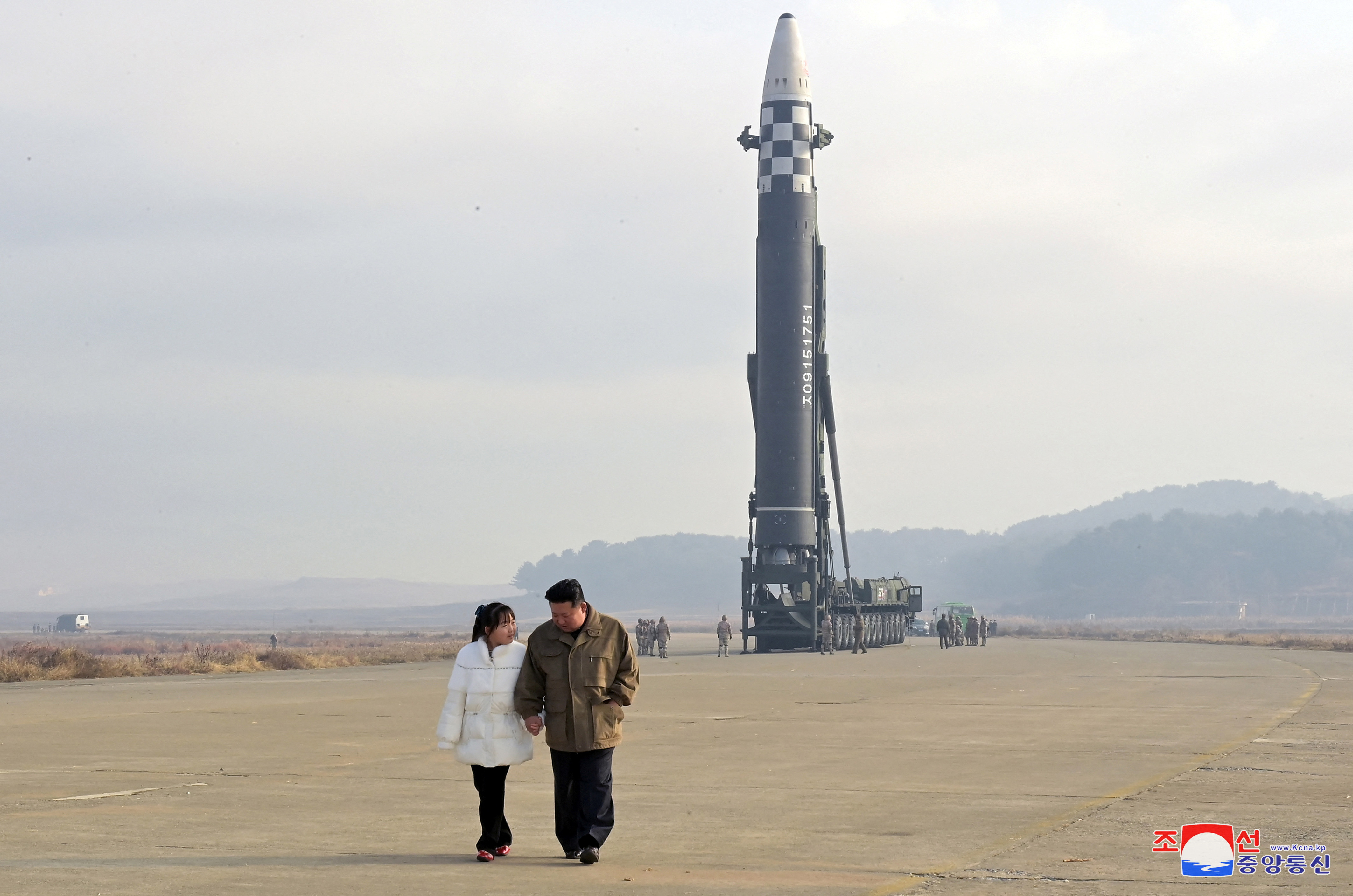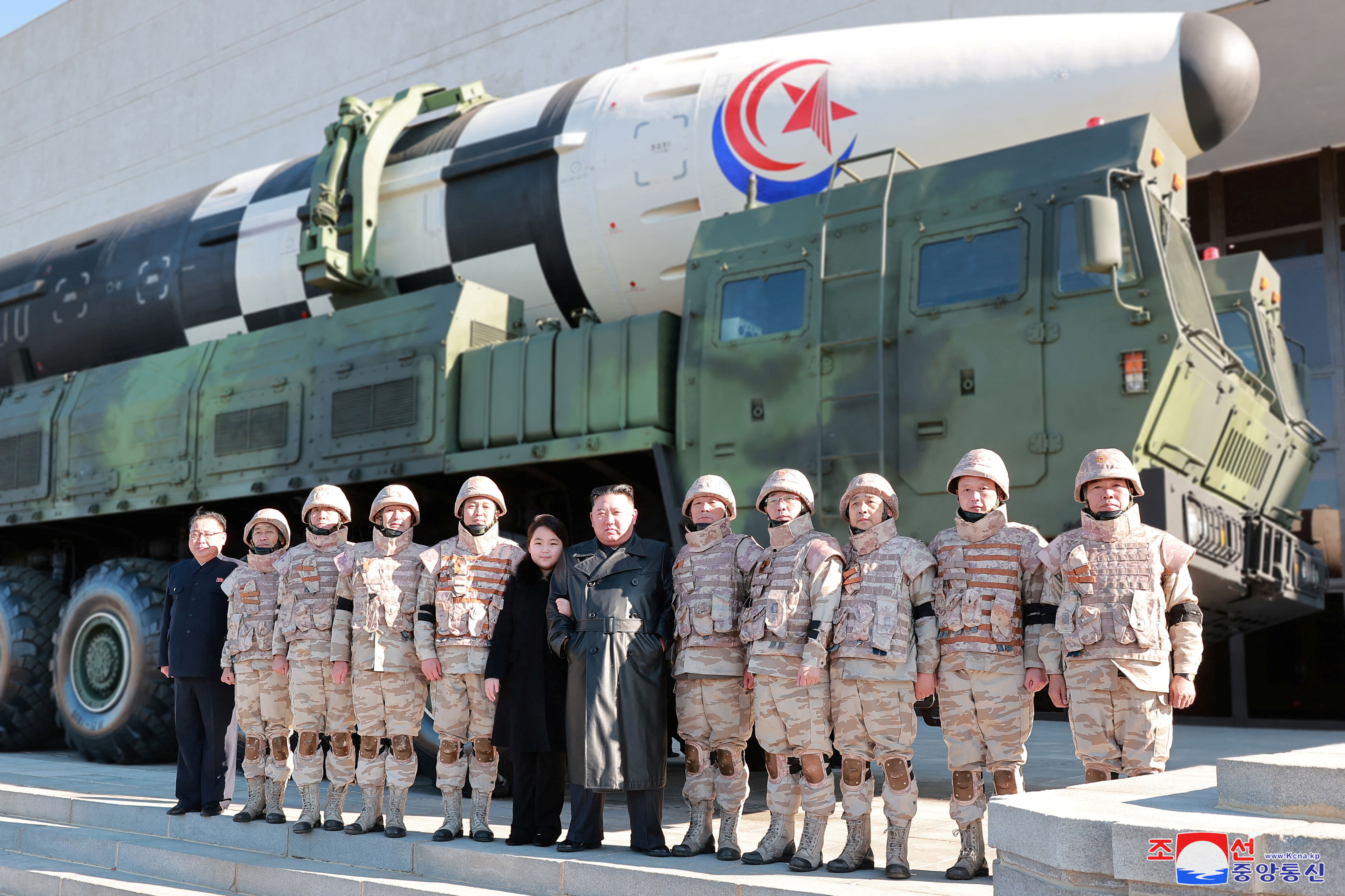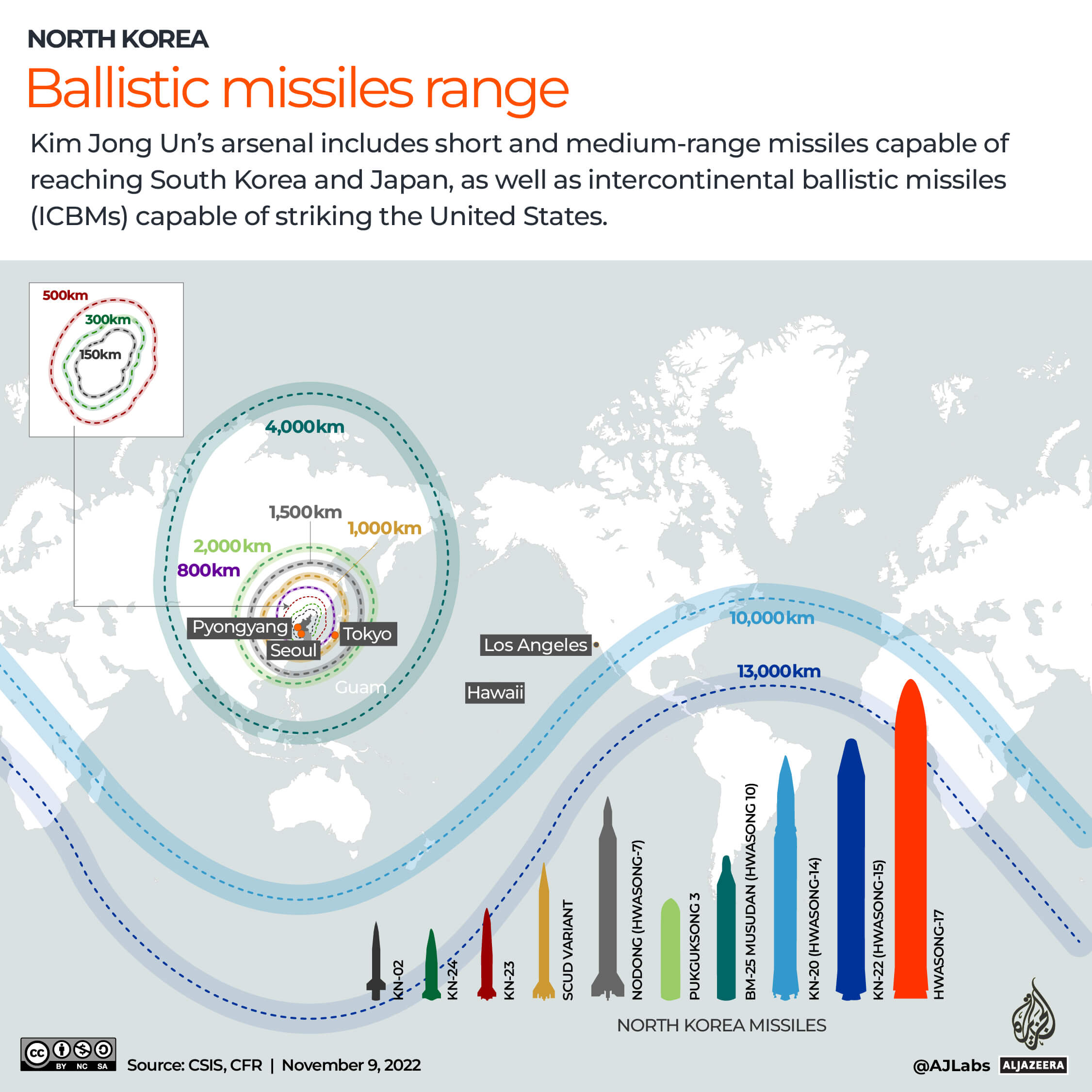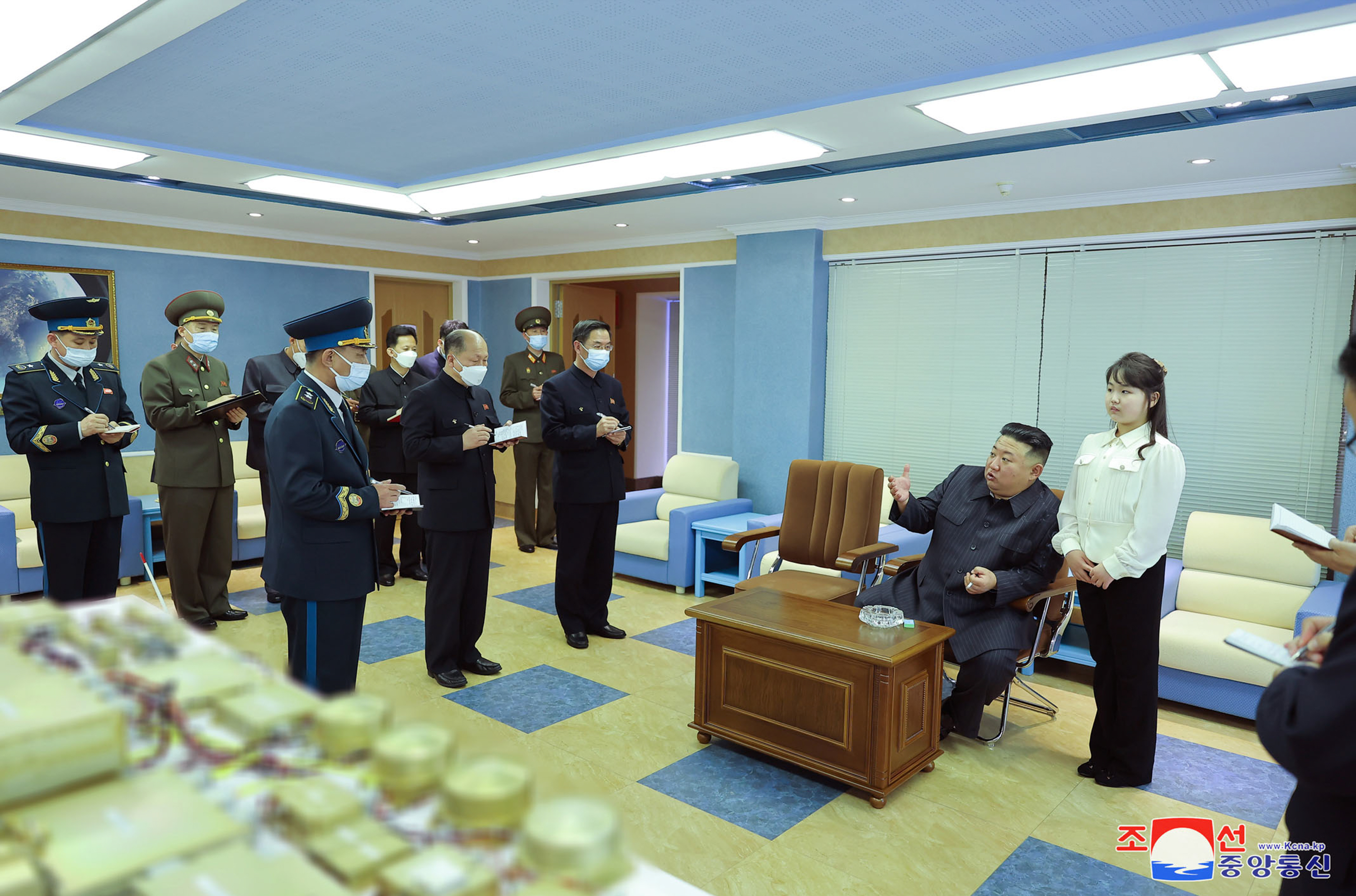
There is nothing arbitrary in how North Korea presents itself to the outside world, or to its own people.
North Korean propaganda is so manicured that analysts monitor its output for the smallest adjustments to national narratives seeking insights into the machinations of one of the world’s most secluded, nuclear-armed states.
Those analysts went into overdrive late last year when one of North Korea’s biggest non-nuclear secrets was revealed: North Korean leader Kim Jong Un’s daughter, believed to be about 10 years old.
Some considered the public presentation of Kim Ju Ae – who has featured extensively in photographs and video footage from the state’s official Korean Central News Agency (KCNA) – as the first steps in a potential succession plan by her father.

Others view her appearance as something more mundane: An attempt by Kim to leverage his image as a family man to shore up support when the North Korean economy is faltering and he is spending lavishly on a ballistic missile programme and developing nuclear capabilities.
While the timing of Ju Ae’s public debut is still being debated, the photogenic youngest is now the closest Pyongyang has to a “crown princess”, says one expert.
‘Crown princess’
Author of “North Korea before Kim Il Sung”, Seoul-based historian and leading North Korea scholar Fyodor Tertitskiy believes the revealing of Ju Ae’s existence was designed to send different messages – one for an international audience and the other for the North Korean public.
The timing of the daughter’s introduction and place of unveiling was also highly symbolic, appearing hand-in-hand with her father at the test launch of North Korea’s ballistic missiles in November.
“The main message is that [she is] sort of like a symbol of power because the first time she appeared was near missiles, and missiles are probably the biggest symbol of North Korea’s military,” Tertitskiy told Al Jazeera.
“The idea is, look how stable we are. No one can attack us because we have these missiles … and our system can last for another generation,” said Tertitskiy, who compared Ju Ae to a “crown princess” – a presumptive heir to her father’s kingdom.

But Tertitskiy believes that the daughter has yet to be anointed as Kim’s successor. Although North Korea’s reputation for secrecy is almost bottomless, hiding a “full-blown succession campaign” would be near to impossible – even in Pyongyang, he says.
Kim appears to be considering his daughter as a future successor, but he has not made up his mind yet. Revealing his daughter now might be a way to test elite opinion in North Korea – a nation whose Politburo membership is almost entirely made up of men.
While Kim is an “entrenched autocrat” and could “theoretically” appoint anyone as his successor, there are still risks if Kim chooses poorly.
“Whoever he puts, they will be unanimously endorsed. But if his success is very unpopular … the regime might not survive. And I guess that’s what might be concerning for him,” Tertitskiy said.
South Korea’s spy agency, the National Intelligence Service (NIS), reported in March that Ju Ae was home-schooled and she enjoyed horse riding, skiing and swimming. The service also believed that Kim had not yet anointed her as heir, pointing out his young age – 39, although her growing public profile appeared to emphasise that succession would be a Kim family affair, South Korean media reported.

Ju Ae is believed to have an elder brother – possibly with a disability – and a younger sibling whose gender is not known, the NIS reported.
According to Tertitskiy, Kim may be waiting for opinions to surreptitiously seep back regarding his daughter, and based on that unofficial feedback “it’s possible that he’ll make a final decision based on what he hears”.
What appears unusual is that Kim is still relatively young and yet he seems concerned with who will continue the Kim family line, he said.
“It’s quite early for him to be concerned” about succession.
Missiles, the military, and Ju Ae
There is a theme to the young girl’s public appearances and the propaganda generated, notes Rachel Minyoung Lee, a former North Korea analyst for almost two decades with the US Central Intelligence Agency’s Open Source Enterprise.
Ju Ae has appeared primarily at military events and alongside the country’s ballistic weapons arsenal, including the fearsome Hwasong-17 intercontinental ballistic missiles (ICBMs), said Lee, who is now a non-resident fellow at the 38 North programme with the Stimson Center think tank in Washington, DC.
Those appearances convey the “powerful message” that “continued weapons development is essential for the security of future generations”, Lee says.
“At the reception on the army founding day, also attended by the daughter, Kim Jong Un gave a speech where he emphasised the importance of having a powerful military ‘generation after generation’, again emphasising the security of future generations,” Lee told Al Jazeera.
“We may view her other two appearances – touring a missile facility and watching the military parade – in the same vein.”


For Lee, more evidence is necessary to view Ju Ae’s appearances as signalling a succession plan. More likely, the father has unveiled the daughter for his own propaganda benefits as the current leader, rather than for Ju Ae’s benefit as a possible future successor.
“North Korean television showed the daughter laughing with her father and stroking his face. No North Korean will see those images and think of her as the next in line to the Kim family throne. In short, I believe the photos and videos of the daughter were part of the Kim Jong Un leadership propaganda, not the daughter’s propaganda,” Lee says.
For more than a decade, North Korean propaganda has focused on Kim’s “pragmatism and realistic leadership” style, portraying him as a good family man, and a fatherly figure. In short “a normal human being” to which “the people can relate”, she says. Public displays of affection between Kim and his daughter reinforce those themes. Yet the wider political and economic context needs to be considered to better understand Ju Ae’s entrance onto the political stage now, Lee says.

‘All efforts on the economy’
North Korea has shifted quietly in the past few years from what Lee describes as a policy of “all efforts on the economy” to the prioritising of national defence.
Kim’s diversion of scarce resources to spending on North Korea’s military has occurred despite a deteriorating economic situation in the country.
In March, South Korea said Pyongyang appeared to be dealing with a “grave” food situation.
The Stimson Center’s 38 North also said the country’s 2020-21 harvest had “probably failed to satisfy minimum human needs” and that “food availability has likely fallen below the bare minimum with regard to human needs, and on one metric, is at its worst since the country’s famine in the 1990s”.
Extreme weather and border closures with China due to the COVID-19 pandemic had hit the country’s food sector. Food insecurity is not uncommon in North Korea where a devastating famine in the 1990s is believed to have led to the deaths of almost a quarter of a million people, according to conservative estimates. Some say 3.5 million people might have died.
With Kim’s promises to improve the economic conditions of his people going unfulfilled, he is probably looking for a new propaganda strategy to improve his image while spending on weapons, when in fact it is agriculture that needs booster rockets.
“What could be more persuasive and powerful than to mobilise the supreme leader’s daughter to represent future generations?” Lee asked.
Can Ju Ae’s posing with her father and flanked by military generals and missiles really take North Koreans’ minds off their material problems? Does propaganda work that way?

Propaganda in North Korea is quite unlike anywhere else, says the University of Auckland’s Ethan Plaut, an expert on media and communications who has taught courses on political propaganda.
North Korea is probably unique in the amount of propaganda produced, coupled with the lack of alternative information due to suppression of almost all other media, a feat which few – if any – authoritarian regimes have achieved, Plaut tells Al Jazeera.
“Looking at North Korea, we’re really talking about decades-long combination of very strict censorship combined with a kind of flood of propaganda media,” Plaut said.
“So I think that it is in some ways really quite different from what we experienced in a lot of the rest of the world.”
Though Ju Ae’s role might be primarily a propaganda prop for her father as he moves ahead with costly military spending, Seoul-based historian Tertitskiy says that being a model father fits comfortably “within the norms of the North Korean ideology”.
The Kims as hereditary rulers have been hailed as the Great Fathers of North Korea’s people, and the apparent affection between Kim and his daughter may not simply be a highly-refined propaganda image.
Tertitskiy says it is quite possible that there is a genuine closeness between the daughter and her father – the absolute ruler of one of the world’s harshest dictatorships.
“Kim Jong Un, at least, he projects an image of a very loyal husband to his wife … and now also as a good father,” Tertitskiy said.
“The best … we can say about this man is that he loves his family.”







